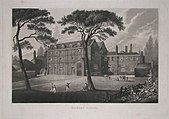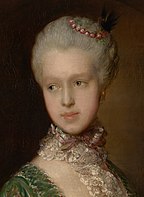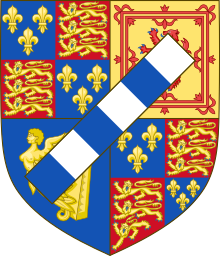| His GraceThe Duke of GraftonKG PC | |
|---|---|
 Portrait by Nathaniel Dance-Holland Portrait by Nathaniel Dance-Holland | |
| Prime Minister of Great Britain | |
| In office 14 October 1768 – 28 January 1770 | |
| Monarch | George III |
| Preceded by | The Earl of Chatham |
| Succeeded by | Lord North |
| Northern Secretary | |
| In office 12 July 1765 – 14 May 1766 | |
| Prime Minister | The Marquess of Rockingham |
| Preceded by | The Earl of Halifax |
| Succeeded by | Henry Seymour Conway |
| Personal details | |
| Born | Augustus Henry FitzRoy (1735-09-28)28 September 1735 |
| Died | 14 March 1811(1811-03-14) (aged 75) Euston, Suffolk, England |
| Resting place | St Genevieve Churchyard, Euston, Suffolk, England |
| Political party | Whig |
| Spouses |
(m. 1769) |
| Children | 12; including George, William and John |
| Parent |
|
| Alma mater | Peterhouse, Cambridge |
| Signature | |
Augustus Henry FitzRoy, 3rd Duke of Grafton (28 September 1735 – 14 March 1811), styled Earl of Euston between 1747 and 1757, was a British Whig statesman of the Georgian era. He is one of a handful of dukes who have served as prime minister.
He became prime minister in 1768 at the age of 33, leading the supporters of William Pitt, and was the youngest person to hold the office until the appointment of William Pitt the Younger 15 years later. However, he struggled to demonstrate an ability to counter increasing challenges to Britain's global dominance following the nation's victory in the Seven Years' War. He was widely attacked for allowing France to annex Corsica, and stepped down in 1770, handing over power to Lord North.
Background and education
He was a son of Lord Augustus FitzRoy, a captain in the Royal Navy, and Elizabeth Cosby, the daughter of Colonel William Cosby, who served as a colonial Governor of New York. Lord Augustus was the third son of the 2nd Duke of Grafton and Lady Henrietta Somerset, which made FitzRoy a great-grandson of both the 1st Duke of Grafton and the Marquess of Worcester. He was notably a fourth-generation descendant of King Charles II and the 1st Duchess of Cleveland; the surname FitzRoy stems from this illegitimacy. His younger brother was the 1st Baron Southampton. Following the death of his uncle in 1747, he was styled Earl of Euston as his grandfather's heir apparent.

Lord Euston was educated at Newcome's School in Hackney and at Westminster School, made the Grand Tour, and obtained a degree at Peterhouse, University of Cambridge.
Political career
In 1756, he entered Parliament as MP for Boroughbridge, a pocket borough; several months later, he switched constituencies to Bury St Edmunds, which was controlled by his family. However, a year later, his grandfather died, and he succeeded as the 3rd Duke of Grafton, which elevated him to the House of Lords.
He first became known in politics as an opponent of Lord Bute, a favourite of King George III. Grafton aligned himself with the Duke of Newcastle against Lord Bute, whose term as prime minister was short-lived largely because it was felt that the peace terms to which he had agreed at the Treaty of Paris were not a sufficient return for Britain's performance in the Seven Years' War.
In 1765, Grafton was appointed a Privy Counsellor; then, following discussions with William Pitt the Elder, he was appointed Northern Secretary in Lord Rockingham's first government. However, Rockingham retired the following year, and Pitt (by then Lord Chatham) formed a ministry in which Grafton was First Lord of the Treasury but not the prime minister.
On 20 September 1769, he was appointed a Knight of the Order of the Garter.
Prime minister
Further information: Grafton ministry| This section needs expansion. You can help by adding to it. (July 2021) |

Chatham's illness, at the end of 1767, resulted in Grafton becoming the government's effective leader (he is credited with entering the office of prime minister in 1768), but political differences, the impact of the Corsican Crisis and the attacks of "Junius" led to his resignation in January 1770. Also, in 1768, Grafton became Chancellor of Cambridge University. He became Lord Privy Seal in Lord North's ministry (1771) but resigned in 1775, being in favour of conciliatory action towards the American colonists. In the second Rockingham ministry of 1782, he was again Lord Privy Seal and continued in the post in the following Shelburne ministry until March 1783.
Militia career

Grafton was a strong supporter of moves to reform the militia during the Seven Years' War, and as Lord Lieutenant of Suffolk his county was one of the first to raise its quota, in two regiments on 27 April 1759. He soon took personal command of the West Suffolk Militia as its Colonel. The militia remained on active service until 1762. The militia was called out again after the outbreak of the War of American Independence when Britain was threatened with invasion by the Americans' allies, France and Spain. On 26 March 1778, Grafton was ordered to embody the two regiments once more. In that summer, the West Suffolks under Grafton formed part of a concentration at Coxheath Camp, near Maidstone in Kent, which was the army's largest training camp. The duke was chosen to train the grenadier companies of all the battalions in camp, and he worked them hard, 7–8 hours a day. Observers of the camp noted that the discipline of the West Suffolk Militia under Grafton was especially good. He resigned his commission on grounds of ill-health in February 1780, and his 20-year-old son and heir, George, Earl of Euston, succeeded him as colonel of the West Suffolk Militia.
Religious interests
In later years Grafton was a prominent Unitarian, being one of the early members of the inaugural Essex Street Chapel under Rev. Theophilus Lindsey when it was founded in 1774. Grafton had associated with a number of liberal Anglican theologians when at Cambridge, and devoted much time to theological study and writing after leaving office as prime minister. In 1773, in the House of Lords, he supported a bill to release Anglican clergy from subscribing to all the Thirty-nine Articles. He became a supporter of moral reform among the wealthy and of changes to the church. He was the author of:
- Hints Submitted to the Serious Attention of the Clergy, Nobility and Gentry, by a Layman (1789).
- Serious Reflections of a Rational Christian from 1788–1797.
He was a sponsor of Richard Watson's Consideration of the Expediency of Revising the Liturgy and Articles of the Church of England (published in 1790), and he funded the printing of 700 copies of Griesbach's edition of the Greek New Testament in 1796.
Horseracing
The Duke also had horse racing interests. His racing colours were sky blue, with a black cap.
Legacy
Grafton County, New Hampshire, in the United States, is named in his honour, as is the city of Grafton, New South Wales, Australia, the town of Grafton, New York, the unincorporated community of Grafton, Virginia, and possibly the township (since 1856 a city) of Grafton, West Virginia. The Grafton Centre Shopping Mall in Cambridge is also named after him and indeed lies on Fitzroy Street. Cape Grafton in Far North Queensland was named after him by Lieutenant James Cook during his first voyage of discovery.
Grafton had the longest post-premiership of any prime minister in British history, totalling 41 years and 45 days.
Family
 Grafton's first wife, Anne Liddell
Grafton's first wife, Anne Liddell Grafton's second wife, Elizabeth Wrottesley
Grafton's second wife, Elizabeth Wrottesley
On 29 January 1756, he married The Hon. Anne Liddell, daughter of Henry Liddell, 1st Baron Ravensworth (1708–1784), at Lord Ravensworth's house in St James's Square, by licence. The marriage was witnessed by Lord Ravensworth and Francis Seymour-Conway, 1st Earl of Hertford.
Augustus and Anne had three children:
- Lady Georgiana FitzRoy (8 May 1757 – 18 January 1799), who married John Smyth (12 February 1748 – 12 February 1811) on 4 June 1778.
- George Henry FitzRoy, 4th Duke of Grafton (1760–1844)
- General Lord Charles FitzRoy (14 July 1764 – 20 December 1829), who married, firstly, Frances Mundy (1773 – 9 August 1797) on 20 June 1795, and had one son. He married, secondly, Lady Frances Stewart (24 June 1777 – 9 February 1810) on 10 March 1799 and had three children. His sons Sir Charles FitzRoy (1796–1858), governor of New South Wales, and Robert FitzRoy, the hydrographer, were notable for their achievements.
In 1764, the Duke had a very public affair with the courtesan Nancy Parsons whom he kept at his townhouse and took to the opera, where they allegedly were found in flagrante delicto. This brazen lack of convention offended society's standards. After the Duchess had become pregnant by her own lover, the Earl of Upper Ossory, she and the Duke were divorced by Act of Parliament, passed 23 March 1769. Three months later, on 24 June 1769, the Duke married Elizabeth Wrottesley (1 November 1745 – 25 May 1822), daughter of the Reverend Sir Richard Wrottesley, Dean of Worcester. They had the following children:
- Lord Henry FitzRoy (9 April 1770 – 7 June 1828), clergyman; he married Caroline Pigot (died 1 January 1835) on 10 September 1800 and had five children. Ancestor of Daisy Greville, Countess of Warwick.
- Lord Frederick FitzRoy (born 16 September 1774; died young).
- Lady Augusta FitzRoy (1779 – 29 June 1839), who married Rev. George F. Tavel (died 1829) on 19 November 1811.
- Lady Frances FitzRoy (1 June 1780 – 7 January 1866), who married the 1st Baron Churchill on 25 November 1800.
- Admiral Lord William FitzRoy (1 June 1782 – 13 May 1857), who married Georgiana Raikes (died 2 December 1861) in 1816 and had two children.
- Lord John Edward FitzRoy (24 September 1785 – 28 December 1856), MP, died unmarried.
- Lady Charlotte FitzRoy (died 23 June 1857).
- Lady Elizabeth FitzRoy (died 13 March 1839), who married her cousin Lt. Gen. The Hon. William FitzRoy (1773–1837), son of the 1st Baron Southampton, on 4 July 1811.
- Lady Isabella FitzRoy (died 10 December 1866), who married Barrington Pope Blachford (3 December 1783 – 14 May 1816) on 11 August 1812.
Grafton is thus the first British prime minister before Anthony Eden (and one of only three) to have been divorced, and the second, after Robert Walpole, to marry while in office. Grafton would be the only prime minister to divorce and remarry while in office until Boris Johnson in 2021. FitzRoy died on 14 March 1811.
Arms

|
|
Cabinet of the Duke of Grafton
This section is transcluded from Grafton ministry. (edit | history)| Portfolio | Minister | Took office | Left office | Party | |
|---|---|---|---|---|---|
| First Lord of the Treasury | The Duke of Grafton(head of ministry) | 14 October 1768 (1768-10-14) | 28 January 1770 (1770-01-28) | Whig | |
| Lord Chancellor | The Lord Camden | 30 July 1766 (1766-07-30) | 17 January 1770 (1770-01-17) | Whig | |
| Charles Yorke | 17 January 1770 (1770-01-17) | 20 January 1770 (1770-01-20) | Independent | ||
| Lord President of the Council | The Earl Gower | 22 December 1767 (1767-12-22) | 24 November 1779 (1779-11-24) | Tory | |
| Lord Privy Seal | The Earl of Bristol | 1768 (1768) | 1770 (1770) | Independent | |
| Lord North | 11 September 1767 (1767-09-11) | 27 March 1782 (1782-03-27) | Tory | ||
| Secretary of State for the Northern Department | The Viscount Weymouth | 20 January 1768 (1768-01-20) | 21 October 1768 (1768-10-21) | Tory | |
| The Earl of Rochford | 21 October 1768 (1768-10-21) | 19 December 1770 (1770-12-19) | Independent | ||
| Secretary of State for the Southern Department | The Earl of Shelburne | 30 July 1766 (1766-07-30) | 20 October 1768 (1768-10-20) | Whig | |
| The Viscount Weymouth | 21 October 1768 (1768-10-21) | 12 December 1770 (1770-12-12) | Tory | ||
| Secretary of State for the Colonies | The Earl of Hillsborough | 27 February 1768 (1768-02-27) | 27 August 1772 (1772-08-27) | Independent | |
| First Lord of the Admiralty | Sir Edward Hawke | 1766 (1766) | 1771 (1771) | Independent | |
| Master-General of the Ordnance | The Marquess of Granby | 14 May 1763 (1763-05-14) | 18 October 1770 (1770-10-18) | Independent | |
| Minister without Portfolio | Henry Seymour Conway | 1768 (1768) | 1770 (1770) | Whig | |
Notes
- "Fitzory, Augustus Henry (FTSY751AH)". A Cambridge Alumni Database. University of Cambridge.
- "Fitzroy, Augustus Henry" . Dictionary of National Biography. London: Smith, Elder & Co. 1885–1900.
- ^
 One or more of the preceding sentences incorporates text from a publication now in the public domain: Chisholm, Hugh, ed. (1911). "Grafton, Dukes of s.v. Augustus Henry Fitzroy". Encyclopædia Britannica. Vol. 12 (11th ed.). Cambridge University Press. p. 317.
One or more of the preceding sentences incorporates text from a publication now in the public domain: Chisholm, Hugh, ed. (1911). "Grafton, Dukes of s.v. Augustus Henry Fitzroy". Encyclopædia Britannica. Vol. 12 (11th ed.). Cambridge University Press. p. 317.
- Institute of Historical Research. "The University of Cambridge: Chancellors". British History Online. Retrieved 11 October 2018.
- Webb, pp. 424–429.
- Western, p. 124; Appendix A.
- Herbert, Charles (1967). "Coxheath Camp, 1778—1779". Journal of the Society for Army Historical Research. 45 (183): 129–148. JSTOR 44226981.
- Durrant 2004, p. 928.
- Weatherby, Edward and James (1801). "COLOURS WORN BY THE RIDERS OF THE FOLLOWING NOBLEMEN, GENTLEMEN, &c". Racing Calendar. 28: 52.
- Gannett, Henry (1905). The Origin of Certain Place Names in the United States. U.S. Government Printing Office. p. 140.
- Shipman, Tim (10 December 2022). "Liz still thinks Trussonomics was right and she's selling her message in America". The Sunday Times. Retrieved 11 December 2022.
The Duke of Grafton, who retired in 1770 aged 34 and lived for another 41 years, was both the youngest prime ministerial retiree and had the longest post-premiership.
- The Register of Marriages solemnized in the Parish Church of St James within the Liberty of Westminster & County of Middlesex. 1754–1765. No. 406. 29 January 1756.
- "Portrait of Lady Georgina Smyth and her son 1780c". Historical Portraits Image Library. Philip Mould Fine Paintings. Archived from the original on 3 March 2016.
- The Register of Births & Baptisms in the Parish of St James within the Liberty of Westminster Vol. IV. 1741–1760. 5 June 1757.
- Chisholm 1911.
- "Anne Fitzpatrick". Oxford Dictionary of National Biography (online ed.). Oxford University Press. doi:10.1093/ref:odnb/88658. (Subscription or UK public library membership required.)
- Durrant 2004.
- Hellicar 1978, p. 28
- Eden's divorce was in 1950 and he remarried in 1952, prior to reaching office as prime minister.
- Shearing, Hazel & Kathryn Snowdon (30 May 2021). "Boris Johnson marries Carrie Symonds at Westminster Cathedral". BBC News. Retrieved 31 May 2021.
Bibliography
- Durrant, Peter (2004). Oxford Dictionary of National Biography. Vol. 19. Oxford University Press. ISBN 978-0-19-861369-5.
- Lt-Col E.A.H. Webb, History of the 12th (The Suffolk) Regiment 1685–1913, London: Spottiswoode, 1914/Uckfield: Naval & Military, 2001, ISBN 978-1-84342-116-0.
- J.R. Western, The English Militia in the Eighteenth Century: The Story of a Political Issue 1660–1802, London: Routledge & Kegan Paul, 1965.
Further reading
- Hellicar, Eileen (1 January 1978). "Duke of Grafton (Augustus Henry Fitzroy)". Prime Ministers of Britain. David & Charles. ISBN 978-0-7153-7486-3.
External links
- The Third Duke of Grafton
- More about Augustus Henry Fitzroy, Duke of Grafton on the 10 Downing Street website.
- Hansard 1803–2005: contributions in Parliament by the Duke of Grafton
- Augustus FitzRoy, 3rd Duke of Grafton
- 1735 births
- 1811 deaths
- 18th-century English nobility
- 19th-century English nobility
- 18th-century English non-fiction writers
- 18th-century Unitarians
- 19th-century Unitarians
- Whig prime ministers of the United Kingdom
- Alumni of Peterhouse, Cambridge
- British officials in the American Revolution
- British racehorse owners and breeders
- Chancellors of the University of Cambridge
- Dukes of Grafton
- Earls of Arlington
- Knights of the Garter
- Lord-lieutenants of Suffolk
- Suffolk Militia officers
- Lords Privy Seal
- Members of the Parliament of Great Britain for English constituencies
- Members of the Privy Council of Great Britain
- People educated at Westminster School, London
- Prime ministers of Great Britain
- Secretaries of state for the Northern Department
- FitzRoy family
- Boroughbridge
- British MPs 1754–1761
- Owners of Epsom Derby winners
- English Unitarians
- MPs for rotten boroughs
- Leaders of the House of Lords
- English people of American descent
